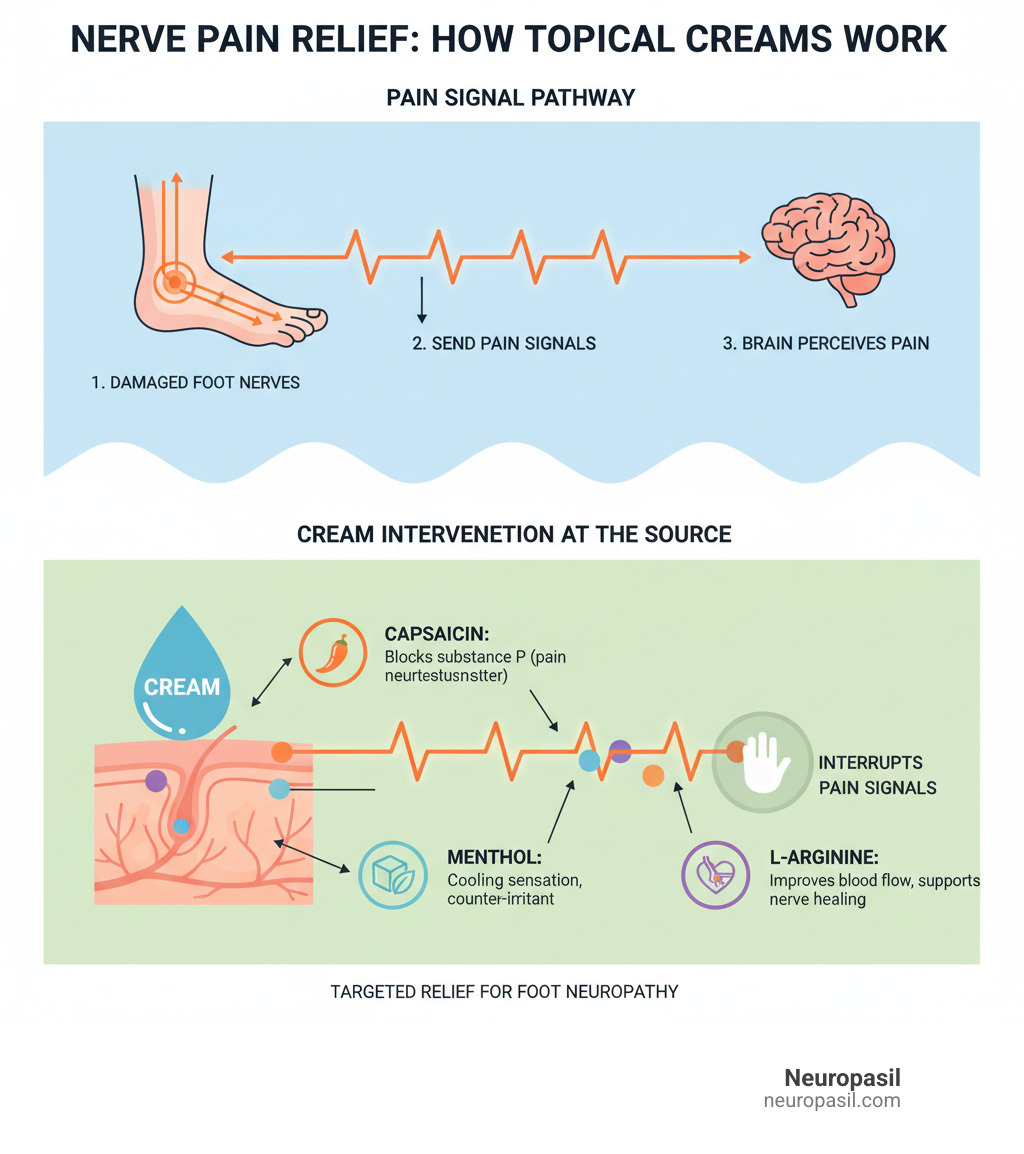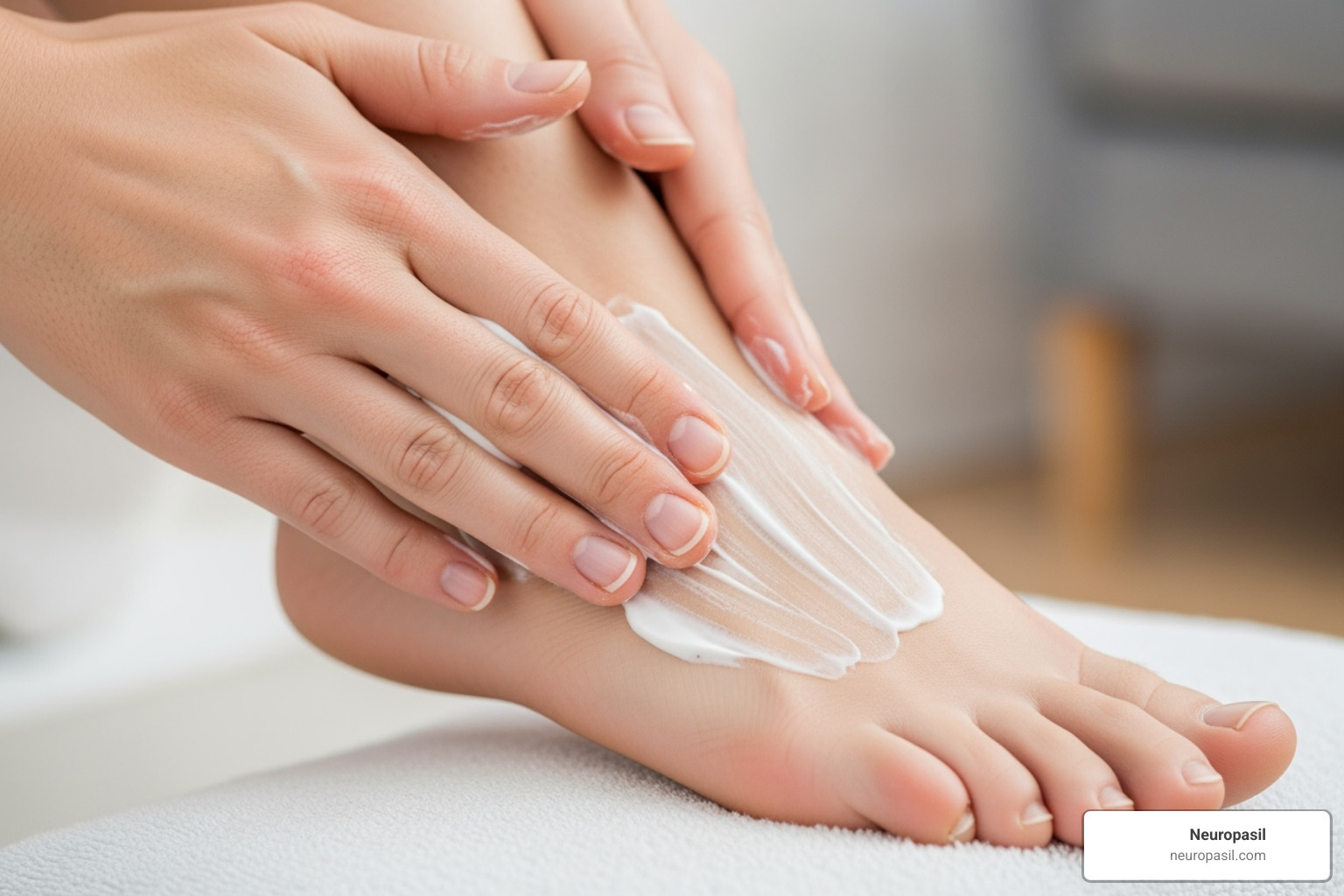Understanding Foot Neuropathy and Why Specialized Creams Matter
Foot neuropathy cream offers targeted relief for one of the most frustrating conditions affecting your feet - nerve damage that causes burning, tingling, numbness, and shooting pain. If you're dealing with these symptoms, you're not alone: peripheral neuropathy affects millions of people, often caused by diabetes, chemotherapy treatments, or chronic nerve irritation.
Quick Guide to Foot Neuropathy Creams:
- Capsaicin creams - Block pain signals from reaching your brain
- Menthol-based formulas - Provide cooling relief and counter-irritant effects
- L-Arginine creams - Improve blood flow to damaged nerves
- Natural ingredient blends - Include arnica, aloe vera, and B-vitamins for gentle healing
- Application frequency - Most effective when used 2-3 times daily consistently
The beauty of topical creams lies in their ability to deliver active ingredients directly to the affected area. Unlike oral medications that must travel through your entire system, these specialized formulas work right where you need them most - penetrating the skin to reach irritated nerve endings in your feet and ankles.
Research shows that ingredients like capsaicin can significantly improve pain for people with diabetic neuropathy, while menthol has proven effective for chemotherapy-induced nerve pain. Some people experience relief within minutes, while others may need several weeks of consistent use to see full benefits.
Whether you're an athlete dealing with overuse injuries or someone managing chronic conditions like diabetes, the right foot neuropathy cream can be a game-changer for getting back to the activities you love.

When nerves in your body get damaged, it’s called neuropathy. This condition can cause chronic pain, making everyday activities a challenge. If you experience numbness, burning, or tingling in your hands or feet, that's peripheral neuropathy. For a deeper dive into the sensations you might be feeling, check out our guide on Peripheral Neuropathy Symptoms.
Topical creams offer a fantastic, localized way to manage this discomfort. They deliver medication directly to the affected area, minimizing systemic side effects often associated with oral medications. This targeted approach can be particularly beneficial for foot neuropathy, where the pain is often concentrated and persistent. Let's explore how these creams work their magic.
The Science Inside the Tube: Active Ingredients and How They Work
Imagine rubbing a soothing balm directly onto a sore muscle—that's the basic idea behind how topical creams work for nerve pain. These specialized formulas are designed to deliver active ingredients right where they're needed. The skin absorbs these compounds, allowing them to interact with nerve endings and other pain receptors in the affected area. This localized action helps manage the pain and discomfort associated with foot neuropathy without requiring the ingredients to travel through your entire bloodstream, offering a more direct route to relief.
These creams often fall into two main categories: analgesic and anesthetic. Analgesic creams primarily work by reducing pain signals or inflammation, while anesthetic creams directly numb the area, temporarily blocking nerve impulses. Many foot neuropathy creams combine elements of both to provide comprehensive relief.

Common Pain-Relieving Ingredients
When we look at the labels of popular foot neuropathy creams, certain ingredients pop up again and again due to their proven ability to provide relief.
Capsaicin
Derived from the humble chili pepper, capsaicin is a powerful ingredient often used in topical creams for neuropathy pain relief. How does it work? Capsaicin targets a specific receptor called TRPV1 (Transient Receptor Potential Vanilloid 1) on nerve cells. By repeatedly activating this receptor, capsaicin eventually desensitizes the nerve endings, making it harder for them to send pain signals to the brain. Think of it like constantly ringing a doorbell until the battery dies – the nerves eventually get tired and stop signaling pain.
Studies suggest that capsaicin creams can significantly improve pain for individuals with conditions like diabetic neuropathy. For instance, high-concentration capsaicin patches (like Qutenza) are sometimes prescribed for diabetic neuropathy in the feet, providing long-lasting relief after just one application. You can learn more about the scientific research behind capsaicin's mechanisms in this detailed review: Scientific research on Capsaicin's mechanisms. Another study highlights its efficacy in chronic neuropathic pain: Topical capsaicin (high concentration) for chronic neuropathic pain in adults.
Lidocaine
Lidocaine is another common ingredient, acting as a local anesthetic. It works by numbing the affected area, essentially blocking the nerves from sending pain signals to the brain. This is particularly useful for acute, localized pain. Topical lidocaine treatments have been found to help people with peripheral neuropathic pain who cannot take oral medications or have adverse reactions to other treatments. It's often used for conditions like post-herpetic neuralgia (nerve pain after shingles) and can be found in various forms, from creams to patches. For more information, refer to Lidocaine topical.
Menthol
Found in mint plants, menthol is used in creams to provide a cooling sensation. This cooling effect is more than just refreshing; it acts as a counter-irritant. By creating a different sensation, it distracts the brain from the underlying pain signals. Menthol products have shown effectiveness in helping people with nerve pain from chemotherapy, offering a promising avenue for relief. A study on this can be found here: Topical menthol for treatment of chemotherapy-induced peripheral neuropathy. The cooling sensation can be quite soothing for burning neuropathic pain.
Nerve-Supporting and Natural Ingredients
Beyond the heavy-hitters like capsaicin and lidocaine, many foot neuropathy creams incorporate ingredients aimed at supporting overall nerve health and providing gentle, natural relief.
L-Arginine
L-Arginine is an amino acid that plays a crucial role in the body. In the context of neuropathy creams, it's believed to stimulate the release of nitric oxide. Nitric oxide is a vasodilator, meaning it helps to widen blood vessels, improving blood flow. Improved blood flow can refresh nerve pathways, delivering essential nutrients and oxygen to damaged nerves, potentially aiding in their recovery and reducing symptoms like numbness and tingling.
CoQ10, B-Vitamins, and Acetyl-L-Carnitine
Several vitamins and compounds are vital for nerve health and are often included in specialized foot neuropathy creams.
- CoQ10 (Coenzyme Q10): This powerful antioxidant is essential for cellular energy production. Some creams include CoQ10, as it's believed to support nerve function and protect against damage.
- B-Vitamins (B12, B6): Especially Vitamin B12 (methylcobalamin) and Vitamin B6, are crucial for nerve fiber integrity and function. Deficiencies in B12, for example, can directly cause neuropathy. Topical application of these vitamins aims to support nerve rejuvenation and overall nerve health.
- Acetyl-L-Carnitine: This amino acid derivative is thought to support nerve fiber regeneration and improve vibration perception, making it a valuable addition to nerve support formulas.
- Vitamin E and D: These vitamins also play roles in nerve protection and function. Vitamin E supports nerves against demyelination (damage to the protective sheath around nerves), while Vitamin D is important for neurological development and healthy nerve function.
- MSN (Methylsulfonylmethane): Often included for its anti-inflammatory properties, MSN can help reduce inflammation around nerve endings, contributing to pain relief.
These ingredients are aimed at not just masking pain but actively supporting the health and repair of damaged nerves.
Arnica, Aloe Vera, Peppermint Oil, and Other Botanicals
Many creams also harness the power of natural botanicals to soothe and calm irritated areas.
- Arnica Montana: Known for its anti-inflammatory properties, arnica can help reduce swelling and improve circulation, potentially aiding in nerve healing.
- Aloe Vera: A natural soother, aloe vera can calm irritated skin and provide a cooling effect, which is particularly welcome for burning sensations.
- Peppermint Oil: Similar to menthol (its primary active compound), peppermint oil provides a cooling sensation and can act as a mild analgesic. Some studies, cited by the NIH, suggest topically applied peppermint oil can be effective at treating neuropathy pain.
- Ginger: Ginger oil contains zingibain, which has potent anti-inflammatory properties that may help reduce neuropathic pain.
- Calendula: This flower extract is often used for its skin-healing and anti-inflammatory benefits, making it excellent for sensitive or compromised skin.
These natural additions provide a holistic approach to comfort, often included to reduce inflammation, improve circulation, and offer a gentle, soothing effect. For a broader perspective on how plants can help, explore this review on Medicinal herbs in the treatment of neuropathic pain: a review.
Your Guide to Choosing the Best Foot Neuropathy Cream
Finding the perfect foot neuropathy cream doesn't have to feel overwhelming. Think of it like finding the right pair of shoes - what works wonderfully for your neighbor might not be the best fit for you. The key is understanding your specific symptoms, knowing your skin type, and matching them with the right ingredients.
Are you dealing with burning sensations that keep you up at night? Or maybe it's more of a tingling numbness that makes walking uncomfortable? Different symptoms often respond better to different ingredients. For instance, if you're experiencing intense burning pain, a capsaicin-based cream might be your best bet. But if your skin tends to be sensitive, you might want to start with something gentler like an L-Arginine formula.

Your skin type plays a huge role in this decision too. If you have diabetes, your skin might be more delicate and slower to heal. People with sensitive skin need to be extra careful about ingredients that could cause irritation or allergic reactions.
What to Look For (and Avoid) on the Label for your foot neuropathy cream
Reading cream labels might seem tedious, but it's actually your first line of defense against choosing something that could make your symptoms worse instead of better.
For sensitive or diabetic skin, you'll want to be particularly choosy. Diabetes can make your skin more fragile and prone to slow healing, so gentle formulations are essential. Look for paraben-free formulas that won't clog pores or cause additional irritation. Hypoallergenic options are specifically designed to minimize allergic reactions.
Ingredients like organic aloe vera, arnica, and calendula are generally well-tolerated and can actually help heal damaged skin while providing relief. Some creams, like those containing 25 different vitamins and minerals, focus on nourishing and rebuilding damaged skin rather than just masking the pain.
Non-greasy textures are also important - nobody wants to slip around in their shoes or leave marks on their socks. The best foot neuropathy creams absorb quickly and leave your skin feeling comfortable, not sticky or oily.
Here's what to watch out for: avoiding high-concentration menthol is crucial. While a little menthol can provide pleasant cooling relief, concentrations over 3% can actually cause burns. The FDA has issued warnings about serious burns from topical pain relievers containing high levels of menthol. It's one of those "more isn't always better" situations.
Formulations for diabetic skin often skip potentially irritating ingredients like synthetic fragrances, isopropyl alcohol, and high-concentration capsaicin. Instead, they focus on plant-based, neuro-natural ingredients that support both nerve health and skin healing.
When you're comparing products, consider whether you want an over-the-counter option or if you might need something stronger. OTC creams are great for mild to moderate symptoms and are easily accessible at pharmacies, supermarkets, and online. If your symptoms are more severe, your doctor might recommend prescription-strength formulations with higher concentrations of active ingredients.
Price-wise, expect to pay anywhere from $15 to $40 or more for a quality foot neuropathy cream. While it might be tempting to go for the cheapest option, you're investing in your comfort and quality of life. Compare prices per ounce to get the best value, and don't forget that many companies offer satisfaction guarantees if you're not happy with the results.
Application, Safety, and Getting the Most from Your Cream
You've done the research and picked your perfect foot neuropathy cream – now comes the fun part of actually using it! Think of this as your personal tutorial for getting the most relief possible. Like learning to ride a bike, proper technique makes all the difference between wobbling around and cruising smoothly.

How to Apply Your Cream for Maximum Effectiveness
The secret to success with any foot neuropathy cream isn't just what you use – it's how you use it. Many people make the mistake of treating it like regular lotion, but these specialized creams deserve a bit more attention.
Start fresh every time. Clean, dry feet are your foundation for success. Just like painting a wall, you want a clean surface for the best results. Wash your feet gently with soap and water, then pat them completely dry. Any leftover moisture or dirt can create a barrier that prevents the active ingredients from doing their job.
Less is often more when it comes to application. Squeeze out a small dollop – about the size of a dime – and warm it between your palms first. This helps the cream spread more evenly and absorb better. If you find yourself using so much that it takes more than 45 seconds to massage in, you're probably overdoing it.
Think like you're putting on an invisible sock. Massage the cream thoroughly into every part of your foot, paying special attention to the areas where you feel the most discomfort. Don't forget the spaces between your toes – neuropathy pain loves to hide in these forgotten spots. Work your way up to include your entire ankle area too, since many of the nerves that affect your feet actually pass through this region.
Consistency beats intensity every single time. Most creams work best when applied 2-3 times daily – think morning coffee routine and evening wind-down. Your nerves need that regular, gentle reminder that relief is coming. Skipping days is like stopping mid-conversation with your nervous system.
After you've finished your application ritual, wash your hands thoroughly with soap and water. This is especially important with capsaicin-containing creams – trust me, you don't want to accidentally rub your eyes later! Also, try to avoid jumping straight into the shower or bath, as water can wash away your cream before it has time to work its magic.
Potential Side Effects and Important Precautions
Even the gentlest foot neuropathy cream is still medicine, and like any medicine, it comes with a few things to watch out for. The good news? Most people tolerate these creams beautifully when used properly.
Capsaicin can be a bit feisty at first. If your cream contains this chili pepper extract, expect some initial burning, tingling, or itching sensations. Think of it as your nerves having a brief conversation with the medicine – usually lasting just a few minutes. This sensation typically calms down as your skin gets used to the treatment, but never apply capsaicin to broken, cut, or irritated skin.
Menthol requires respect, especially in higher concentrations. While that cooling sensation feels wonderful, products with menthol concentrations over 3% can actually cause serious burns. The FDA has issued warnings about rare cases of serious burns from over-the-counter topical pain relievers. If the cooling turns into genuine burning, wash it off immediately.
Your skin is the best teacher when it comes to tolerance. Always perform a patch test before going all-in with a new cream. Apply a small amount to your inner forearm and wait 24-48 hours to see how your skin reacts. This simple step can save you from unnecessary discomfort and help you determine if a product is right for you.
When in doubt, ask your doctor. This becomes especially important if you're managing diabetes, taking other medications, or dealing with any skin conditions. Your healthcare provider knows your unique situation best and can guide you toward the safest, most effective options. They can also help you understand how topical treatments fit into your overall pain management plan.
These creams are designed to help, not hurt. Most side effects are mild and temporary, but paying attention to your body's signals will help you get the relief you're seeking safely.
Frequently Asked Questions about Neuropathy Creams
Living with foot neuropathy brings up so many questions, and we get it. When you're dealing with burning, tingling, or numbness in your feet, you want real answers about what might help. Let's explore the questions we hear most often about foot neuropathy creams.
How long does it take for a neuropathy cream to work?
This is probably the first thing on your mind when you're considering a new cream - and honestly, the answer depends on what's inside that tube. Think of it like different instruments in an orchestra - they each play their part at different times.
Menthol-based creams work almost like magic tricks. You'll feel that cooling sensation within minutes of application, providing immediate distraction from burning pain. It's not a cure, but it can give you blessed relief when you need it most.
Capsaicin creams are more like marathon runners than sprinters. These need time to work their magic on your nerve endings - typically several days to a few weeks of consistent use before you notice significant pain reduction. The ingredient literally trains your nerves to stop sending so many pain signals, but this process takes patience.
Nerve-supporting ingredients like L-Arginine, B-vitamins, or CoQ10 are in it for the long haul. These work gradually over weeks or months, focusing on actually supporting nerve health rather than just masking symptoms. Some people using L-Arginine creams report feeling increased sensation within minutes, but the real benefits build over time.
The golden rule? Give any new foot neuropathy cream at least 2-4 weeks of consistent use before deciding if it's working for you. Your nerves didn't get damaged overnight, and they won't heal overnight either.
Can I use a foot cream with my oral neuropathy medications?
Great question, and the short answer is usually yes - but let's talk about why this matters. Foot neuropathy creams work locally, right where you apply them, while oral medications travel through your whole system. This means they typically play well together without causing problems.
Many doctors actually love this combination approach. Your oral medication (whether that's gabapentin, pregabalin, or something else) works from the inside out, while your topical cream provides targeted relief right where you're hurting. It's like having backup singers supporting your lead vocalist - they complement each other beautifully.
The cream can often provide that extra layer of comfort without requiring you to increase your oral medication doses. This is especially helpful if you're already dealing with side effects from pills or want to keep your systemic medication as low as possible.
But here's the important part: always check with your doctor or pharmacist before adding any new treatment to your routine. They know your specific health situation and can spot potential issues you might miss. It's a quick conversation that could save you from unnecessary complications.
For more comprehensive information about natural approaches that work alongside traditional treatments, explore our guide on nerve pain relief with Neuropasil natural solutions.
Are there exercises that can help along with the cream?
Absolutely! Think of your foot neuropathy cream as one player on your relief team - it works even better when it has good teammates. Exercise might sound daunting when your feet are bothering you, but the right gentle movements can actually boost circulation and support nerve health.
Walking is probably your best friend here. Even a gentle 10-15 minute stroll can get blood flowing to your feet and legs, bringing oxygen and nutrients to those struggling nerves. Don't worry about speed or distance - consistency matters more than intensity.
Gentle stretching keeps your feet and ankles flexible, preventing the stiffness that can make neuropathy symptoms worse. Simple ankle circles while you're watching TV or calf stretches against a wall can make a real difference.
Balance exercises are particularly helpful because neuropathy often affects your sense of where your feet are in space. Standing on one foot for 30 seconds or walking heel-to-toe down a hallway can help retrain your nervous system.
Water activities are fantastic if you have access to a pool. The water supports your body weight while providing gentle resistance, making movement easier and more comfortable.
If you're also dealing with foot pain conditions like plantar fasciitis alongside your neuropathy, our detailed guide on exercises for plantar fasciitis includes movements that might help with both issues.
The goal isn't to become a fitness guru overnight. Start small, listen to your body, and always check with your doctor or a physical therapist before beginning any new exercise routine. They can help you find the sweet spot between helpful movement and overdoing it.
Your Next Step Towards Comfortable Feet
Finding relief from foot neuropathy doesn't have to feel like an impossible dream. Throughout this guide, we've walked through the science behind foot neuropathy creams and how they can transform your daily comfort. Whether you're dealing with the burning sensation from diabetic neuropathy or the tingling effects of chemotherapy treatments, the right topical cream can offer targeted relief exactly where you need it most.
The beauty of these specialized creams lies in their variety of approaches to pain relief. Capsaicin works by gradually desensitizing overactive nerve endings, while menthol provides immediate cooling comfort for burning sensations. L-Arginine supports better blood flow to damaged nerves, and natural ingredients like arnica and aloe vera offer gentle, soothing care for sensitive skin.
Choosing the right cream is just the beginning of your journey. Success comes from consistent application, understanding your skin's needs, and being patient as your body responds to treatment. Some people feel relief within minutes, while others may need several weeks to experience the full benefits.
The most encouraging part? You don't have to tackle neuropathy alone. These creams work beautifully alongside other treatments - from your doctor's prescribed medications to gentle exercises that improve circulation. It's all about creating a comprehensive approach that fits your lifestyle and needs.
At Neuropasil, we understand that every person's experience with nerve discomfort is unique. That's why we're passionate about providing natural, effective solutions that work with your body's healing processes. We believe that with the right knowledge and tools, you can take meaningful steps toward better comfort and mobility.
Your feet carry you through life's adventures - they deserve the best care possible. Ready to explore more ways to support your nerve health? Find comprehensive strategies for nerve pain relief with Neuropasil and take that important first step toward the comfortable, active life you deserve.














